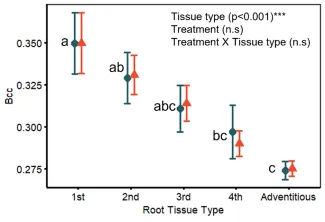Successful application of the 13C label to a tundra wetland ecosystem.
Despite performing a crucial role connecting primary producers to the soil, plant roots are relatively understudied in the Arctic, and their functional response to rapidly warming climate is largely unknown. Therefore, the team assessed whether one growing season of elevated temperature would affect belowground carbon dynamics in the tundra. In 2021, the team conducted a field campaign in Utqiaġvik, Alaska, to sample zero-power warming chambers that elevate air temperatures by around 3°C–4°C during the peak growing season. The team looked at the uptake of 13C-CO2 by the sedge Carex aquatilis during a 1 h, midday labelling event. For a 5-day period following the labelling event, the team collected daily leaf samples and daily soil porewater samples in these inundated plots. On the fifth day, above- and belowground plant biomass was harvested, and soil microbial biomass was measured. Preliminary analysis of these samples indicates successful incorporation of the 13C label into Carex blades. In fine roots tissues, blue coloration was more common on the most distal, low-order tissues. The blue color may be the result of iron-oxide plaques forming on root surfaces following the introduction of oxygen into an otherwise saturated rhizosphere. The team is quantifying the relationship between root color and metal plaques by comparing RGB color extraction of root scans to data from an environmental scanning electron microscope as part of a collaboration with Beth Herndon (Oak Ridge National Laboratory), Kathleen Coffman (summer 2022 SULI participant), and Patrick Hodgson (fall 2022 SULI program participant). Future analyses will quantify the transfer of recent photosynthate to soil porewater and the soil microbial community, as well as allocation of this photosynthate within aboveground plant tissues
For more information, please contact:
Verity Salmon
salmonvg@ornl.gov

